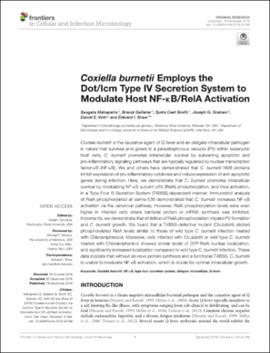| dc.contributor.author | Mahapatra, Saugata | |
| dc.contributor.author | Gallaher, Brandi | |
| dc.contributor.author | Smith, Sydni Caet | |
| dc.contributor.author | Graham, Joseph G. | |
| dc.contributor.author | Voth, Daniel E. | |
| dc.contributor.author | Shaw, Edward I. | |
| dc.date.accessioned | 2019-08-28T16:00:47Z | |
| dc.date.available | 2019-08-28T16:00:47Z | |
| dc.date.issued | 2016-12-19 | |
| dc.identifier | oksd_mahapatra_coxiellaburneti_2016 | |
| dc.identifier.citation | Mahapatra, S., Gallaher, B., Smith, S. C., Graham, J. G., Voth, D. E., & Shaw, E. I. (2016). Coxiella burnetii employs the Dot/Icm type IV secretion system to modulate host NF-KB/RelA activation. Frontiers in Cellular and Infection Microbiology, 6, Article 188. https://doi.org/10.3389/fcimb.2016.00188 | |
| dc.identifier.uri | https://hdl.handle.net/11244/321369 | |
| dc.description.abstract | Coxiella burnetii is the causative agent of Q fever and an obligate intracellular pathogen in nature that survives and grows in a parasitophorous vacuole (PV) within eukaryotic host cells. C. burnetii promotes intracellular survival by subverting apoptotic and pro-inflammatory signaling pathways that are typically regulated by nuclear transcription factor-κB (NF-κB). We and others have demonstrated that C. burnetii NMII proteins inhibit expression of pro-inflammatory cytokines and induce expression of anti-apoptotic genes during infection. Here, we demonstrate that C. burnetii promotes intracellular survival by modulating NF-κB subunit p65 (RelA) phosphorylation, and thus activation, in a Type Four B Secretion System (T4BSS)-dependent manner. Immunoblot analysis of RelA phosphorylated at serine-536 demonstrated that C. burnetii increases NF-κB activation via the canonical pathway. However, RelA phosphorylation levels were even higher in infected cells where bacterial protein or mRNA synthesis was inhibited. Importantly, we demonstrate that inhibition of RelA phosphorylation impairs PV formation and C. burnetii growth. We found that a T4BSS-defective mutant (CbΔdotA) elicited phosphorylated RelA levels similar to those of wild type C. burnetii infection treated with Chloramphenicol. Moreover, cells infected with CbΔdotA or wild type C. burnetii treated with Chloramphenicol showed similar levels of GFP-RelA nuclear localization, and significantly increased localization compared to wild type C. burnetii infection. These data indicate that without de novo protein synthesis and a functional T4BSS, C. burnetii is unable to modulate NF-κB activation, which is crucial for optimal intracellular growth. | |
| dc.format | application/pdf | |
| dc.language | en_US | |
| dc.publisher | Frontiers Media | |
| dc.rights | This material has been previously published. In the Oklahoma State University Library's institutional repository this version is made available through the open access principles and the terms of agreement/consent between the author(s) and the publisher. The permission policy on the use, reproduction or distribution of the material falls under fair use for educational, scholarship, and research purposes. Contact Digital Resources and Discovery Services at lib-dls@okstate.edu or 405-744-9161 for further information. | |
| dc.title | Coxiella burnetii employs the Dot/Icm type IV secretion system to modulate host NF-KB/RelA activation | |
| osu.filename | oksd_mahapatra_coxiellaburneti_2016.pdf | |
| dc.description.peerreview | Peer reviewed | |
| dc.identifier.doi | 10.3389/fcimb.2016.00188 | |
| dc.description.department | Microbiology and Molecular Genetics | |
| dc.type.genre | Article | |
| dc.type.material | Text | |
| dc.subject.keywords | coxiella burnetii | |
| dc.subject.keywords | nf-?b | |
| dc.subject.keywords | q fever | |
| dc.subject.keywords | obligate intracellular | |
| dc.subject.keywords | type four secretion system | |
